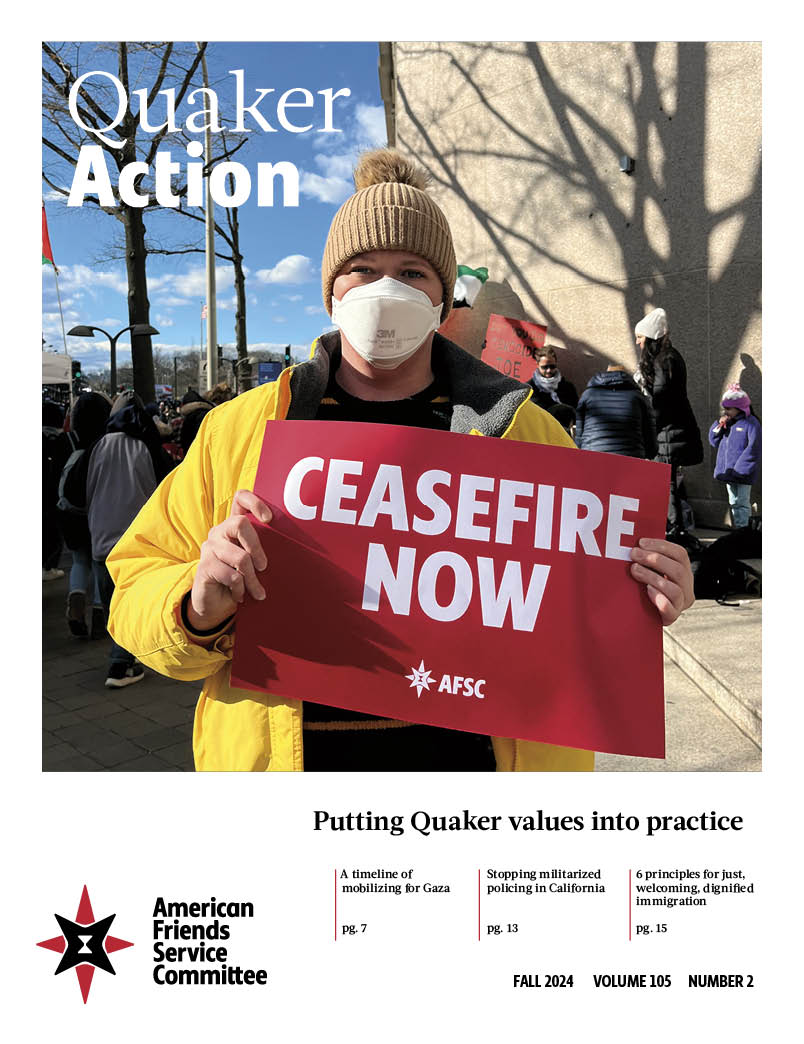
This summer, AFSC organized a gathering in California on police demilitarization. Photos: Brooke Anderson
In California’s Santa Rita jail, a man with mental illness was confined for months in a cramped cell measuring only 7 by 7 feet. Here, he faced the harsh reality of militarized policing firsthand. Prison staff deployed a weapon known as a “Stingball” in that tiny cell. When the Stingball exploded, it released dozens of rubber bullets that ricocheted off the walls at explosive speeds. The man suffered bruises four to six inches wide on his neck, chest, and legs.
Not too far away, in Contra Costa County, deputies at Martinez Jail used similar weapons four times in 2022 alone. In one case, the objective was simply to get a person to take their medications.
These brutal examples are among thousands that illustrate the pervasive use of force in California’s prisons and jails. AFSC’s California Healing Justice Program has documented the issue in our recent report, “22,000 Uses of Force: Hidden Violence of Militarized Weapons in California Prisons and Jails.”
Our report found that over just three years, from 2021 through 2023, California prison staff used:
RUBBER BULLETS 3,145 times
TEAR GAS 113 times
BATONS 1,226 times
PEPPER SPRAY 11,751 times, averaging over 10 uses daily
These numbers represent an extraordinary level of force being routinely deployed in an incarcerated population of just 95,000 people.
The use of militarized force goes beyond prisons and jails. Throughout U.S. history, we have seen law enforcement use these types of weapons against civilians across the country, from college campuses to homes raided by SWAT teams. Typically, there are alternatives to the use of state violence. In the spring of this year, some students taking part in university protests over the crisis in Gaza were met with dialogue and agreements. But most students faced excessive force from police who were summoned by school administrations.
Far too often, the use of militarized weapons against ordinary people goes unreported and even becomes normalized. It's behind prison walls that this pattern is the most alarming and pervasive. Today, it is a human rights crisis that demands our immediate attention and action.
DOCUMENTING THE CRISIS
AFSC has been working with communities across California to document and stop police militarization. We first began requesting California government documents on the use of police weaponry in 2021. It startled us to learn that most uses of police violence, by far, were occurring inside state prisons and jails. Even more disturbing, over three-quarters of these incidents took place against people with mental health diagnoses.
Stopping this form of state violence requires more transparency and accountability. In 2021, California took a crucial step in that direction by passing AB481. The groundbreaking law came after years of advocacy by coalitions that included AFSC and is the first of its kind in the nation. It requires all law enforcement agencies in the state to publish and seek annual approval by local elected officials of policies for militarized equipment acquired from any source. That includes armored vehicles, assault rifles, tear gas, drones, and robots. AB481 also mandates annual reports on the use of the equipment.
Since the passage of the law, AFSC has worked with activists across the state—from Chula Vista at the U.S.-Mexico border to suburbs like Los Altos, to cities such as Sacramento, Oakland, and San Francisco—to analyze the arsenals and use policies of militarized gear owned by law enforcement agencies, including the sheriffs that run jails. Our collective efforts have helped bring unprecedented transparency to police militarization in California.

This summer, AFSC organized a gathering in California on police demilitarization. Photos: Brooke Anderson
However, documenting this information in prisons and jails presents special challenges. People in prison face severe restrictions in speaking about their experiences, because of the nature of incarceration as well as a fear of retaliation. Although California’s state prison agency publishes data on hundreds of uses of force every month, it has repeatedly denied public records requests for any incident reports on those uses of force. For incarcerated people, there are also significant barriers to filing lawsuits like those that have been filed by protesters and others who have faced police violence in the outside world.
SOLUTIONS AND ACTIONS MOVING FORWARD
What can be done about this situation? To start, California must rethink its budget priorities. State and county governments should fund preventative and crisis care as well as access to supportive housing for people with mental illness or substance use disorders and reduce funding for militarized weaponry for state prisons and county jails.
We need systemic change to reduce the number of people imprisoned because of a mental illness or substance use disorder. We must counter narratives of fear and punishment that fuel mass incarceration. Instead, we need policies focused on repairing harm and addressing illness, racism, and economic equality in our society.
Finally, California must do all that it can to stop the use of force in its prisons and jails. The state auditor should perform an audit on the extent, causes, and consequences of using violence against incarcerated people. The state and county governments should explicitly ban the use of Stingballs and other militarized weapons in jails and prisons. We also need more attention from journalists, policymakers, and oversight agencies.
The path forward requires sustained, collective action. Only through these efforts can we end militarized policing in prisons, jails, and our communities. To learn more, visit afsc.org/ab481.

